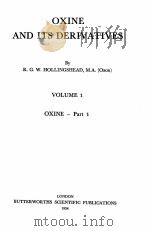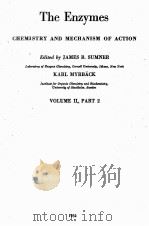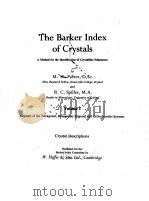《The Enzymes Volume I Part 1》
| 作者 | 编者 |
|---|---|
| 出版 | 未查询到或未知 |
| 参考页数 | 724 |
| 出版时间 | 1951(求助前请核对) 目录预览 |
| ISBN号 | 无 — 求助条款 |
| PDF编号 | 812577348(仅供预览,未存储实际文件) |
| 求助格式 | 扫描PDF(若分多册发行,每次仅能受理1册) |

1.Introduction.&BY JAMES B.SUMENR AND KARL MYRBACK1
Ⅰ.The Role of Enzymes1
Ⅱ.Definitions2
Ⅲ.Terminology and Classification3
Ⅳ.Enzymes as Systems6
Ⅴ.The Early History of Enaymes6
Ⅵ.Some Discoveries and Theories of Fundamental Importance for the Modern Development of Enzyme Chemistry8
Ⅶ.The Chemical Nature of Enzymes19
Ⅷ.Geneeral Properties of Enzymes21
Ⅸ.The Determination of Enzyme Activity24
2.Physical Chemistry and Chemical Kinetics of Enzymes.&BY E.A.MOELWYNE-HUGHES28
Ⅰ.Determination of Molecular Weights of Enzymes29
Ⅱ.Electrophoresis42
Ⅲ.Catalysis55
Ⅳ.Structure and Stability69
3.Enzyme Specificity.&BY BURCKHARDT HELFERICH79
Ⅰ.Introduction79
Ⅱ.Typical Examples of Specificity82
Ⅲ.Specificity of Enzymes as a Basis for their Classification104
Ⅳ.Localization of Specificity in the Enzyme Molecule106
Ⅴ.Inferences about Enzyme Structure Drawn from Enzyme Specificity109
Ⅵ.Summary and Further Development111
4.Enzymes in Relation to Genes,Viruses,Hormones,Vitamins,and Chemotherapeutic Drug Action.&BY M.G.SEVAG,J.S.GOTS,AND E.STEERS115
Ⅰ.Genes and Enzymes116
Ⅱ.Viruses and Enzymes130
Ⅲ.The Relation of Hormones to Enzymes139
Ⅳ.The Relation of Vitamins to Coenzymes153
Ⅴ.Action of Chemotherapeutic Agents on Enzymes157
5.Cytochemical Foundations of Enzyme Chemistry.&BY A.L.DOUNCE187
Ⅰ.Introduction188
Ⅱ.Enzyme Chemistry of Cytoplasm as Deduced from Physicochemical Studies189
Ⅲ.Studies of Cell Nuclei and Chromosomes Isolated by Physicochemical Procedures207
Ⅳ.Studies of the Chemistry of Cell Components as Deduced from Special Physicochemical Techniques234
Ⅴ.Histochemical Procedures240
Ⅵ.Chemistry of Cell Surfaces255
Ⅶ.Enzymes and Genes258
Ⅷ.Summary and Conclusions261
6.Modern Aspects of Enzymatic Adaptation.&BY S.SPIEGELMAN267
Ⅰ.Introduction267
Ⅱ.Some Examples of Enzymatic Adaptation268
Ⅲ.The Operational Description of Enzymatic Adaptation in Microorganisms and its Biological Signficance271
Ⅳ.Enzymatic Constitution and Enzymatic Adaptation276
Ⅴ.The Kinetics of Enzymatic Adaptation279
Ⅵ.The Relation of Enzymatic Adaptation to Cellular Metabolism281
Ⅶ.Interactions between Enzyme-Forming Systems285
Ⅷ.Consequences of Competitive Interactions between Enzyme-Forming Systems289
Ⅸ.The Stabilization of Enzymatic Patterns in the Absence of Substrate294
Ⅹ.The Role of Substrate296
Ⅺ.Specificity Relations in Enzymatic Adaptation299
Ⅻ.Genetic Implications and"Long Term Adaptation"300
ⅩⅢ.Conclusion305
7.Enzyme Inhibition.&BY L.MASSART307
Ⅰ.Introduction.Specific and Nonspecific Inhibition,Competitive and Noncompetitive Inhibition307
Ⅱ.Kinetics of Specific Inhibition310
Ⅲ.Compilation of Examples317
Ⅳ.Influence of Radiations on Enzymes340
8.Enzymes and Immunology.&BY J.R.MARRACK343
Ⅰ.Introduction344
Ⅱ.Reactions between Antibodies and Antigens345
Ⅲ.Specific Combination of Antigen and Antibody350
Ⅳ.Effects of Disorganization of Molecules of Antigens and Antibodies363
Ⅴ.Enzymes as Antigens377
Ⅵ.Toxic Enzymes383
Ⅶ.Complement387
9.Enzymes Hydrolyzing Fats and Esters.&BY ROBERT AMMON AND MAIRE JAARMA390
Ⅰ.Classification of the Esterases and Remarks on the Organization of the Field390
Ⅱ.Brief Survey of Methods of Determination and of Esterase Preparations391
Ⅲ.The Individual Esterases396
10.Acetylcholine Esterase and Cholinesterase.&BY KLAS-BERTIL AUGUSTINSSON443
Ⅰ.Introduction444
Ⅱ.Existence of Specific Esterases for Acetylcholine and Other Choline Esters445
Ⅲ.Measurement of Activity448
Ⅳ.Occurrence of Acetylcholine Esterase and Cholinesterase451
Ⅴ.Enzyme Preparations455
Ⅵ.Activators and Nature of the Active Groups456
Ⅶ.Kinetics458
Ⅷ.Inhibitors462
Ⅸ.Physiological Significance of Acetylcholine-Hydrolyzing Enzymes469
11.Phosphatases.&BY JEAN ROCHE473
Ⅰ.Historical Introduction474
Ⅱ.General Biochemistry of the Phosphatases475
Ⅲ.Biochemistry of the Various Types of Phosphatases484
Ⅳ.Physiological Chemistry of the Phosphatases498
Ⅴ.Pathological Chemistry of the Phosphatases506
Ⅵ.General Conclusions510
12.Metaphosphate and its Enzymatic Breakdown.&BY BJORN LNGELMAN511
Ⅰ.Introduction511
Ⅱ.Enzymatic Breakdown of Metaphosphate511
Ⅲ.Occurrence of Metaphosphate in Microorganisms514
13.Sulfatases.&BY CLAUDE FROMAGEOT517
Ⅰ.Introduction517
Ⅱ.Phenolsulfatase518
Ⅲ.Glucosulfatase521
Ⅳ.Chondrosulfatase523
Ⅴ.Myrosulfatase525
14.Invertase.&BY CARL NEUBERG AND INES MANDL527
Ⅰ.Historical527
Ⅱ.Occurrence528
Ⅲ.Separation531
Ⅳ.Properties535
Ⅴ.Stability536
Ⅵ.Configuration541
Ⅶ.Specificity542
Ⅷ.Mechanism of Invertase Action546
Ⅸ.Kinetics548
Ⅹ.Activity549
Ⅺ.Technical preparations and Applications550
15.ɑ-D-Glucosidases.&BY ALFRED GOTTSCHALK551
Ⅰ.Mode of Contact between Enzyme and ɑ-D-Glycoside551
Ⅱ.Maltases553
Ⅲ.Glucosaccharase557
Ⅳ.Trehalase580
16.β-Glucosidase.&BY STIG VEIBEL583
Ⅰ.Occurrence584
Ⅱ.Preparation and Purification584
Ⅲ.Standardization590
Ⅳ.Specificity593
Ⅴ.Inactivation617
Ⅵ.Enzymatic Synthesis618
17.Hydrolysis of Galactosides,Mannosides,and Thioglycosides.&BY STIG VEIBEL621
Ⅰ.α-Galatosidase621
Ⅱ.β-Galactosidase623
Ⅲ.α-Mannosidase630
Ⅳ.β-Mannosidase633
Ⅴ.Thioglucosidase633
18.β-Glucuronidase.&BY WILLIAM H.FISHMAN635
Ⅰ.Introduction635
Ⅱ.Properties of Glucuronidases637
Ⅲ.Physiological Role of β-Glucuronidase646
Ⅳ.Implications in Human Cancer651
Ⅴ.Summary652
19.Amylases and the Hydrolysis of Starch and Glycogen.&BY KARL MYRBACK AND GUNNAR NEUMULLER653
Ⅰ.The Substrates654
Ⅱ.Enzymatic Degradation of Starch and Glycogen664
Ⅲ.Chemical Nature of Amylases676
Ⅳ.Amylase Inhibitors in Cereals702
Ⅴ.Mechanism of Amylase Action703
Ⅵ.Action of Amylases on Raw Starch720
Ⅶ.Amylase of Bacillus macerans721
1951《The Enzymes Volume I Part 1》由于是年代较久的资料都绝版了,几乎不可能购买到实物。如果大家为了学习确实需要,可向博主求助其电子版PDF文件。对合法合规的求助,我会当即受理并将下载地址发送给你。
高度相关资料
-

- OXINE AND ITS DERIVATIVES VOLUME I ONINE-PART 1
- 1954 BUTTERWORTHS SCIENTIFIC PUBLICATIONS
-

- Cancer Volume 1 Part I Research Into Causation
- 1957 Butterworth & Co.Ltd.
-

- COPPER PROTEINS AND COPPER ENZYMES VOLUME I
- 1984 CRC PRESS INC
-

- THE ENZYMES STRUCTURE AND CONTROL VOLUME I THIRD EDITION
- 1970 ACADEMIC PRESS
-

- THE ENZYMES VOLUME VII THIRD EDITION
- 1972 ACADEMIC PRESS
-

- THE ENZYMES VOLUME XIV NUCLEIC ACIDS PART A THIRD EDITION
- 1981 ACADEMIC PRESS
-

- THE CAMBRIDGE MEDIEVAL HISTORY VOLUME IV THE BYZANTINE EMPIRE PART I
- 1979 CAMBRIDGE UNIVERSITY PRESS
提示:百度云已更名为百度网盘(百度盘),天翼云盘、微盘下载地址……暂未提供。➥ PDF文字可复制化或转WORD







